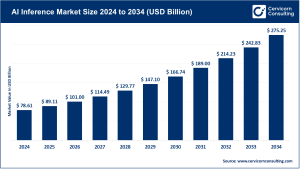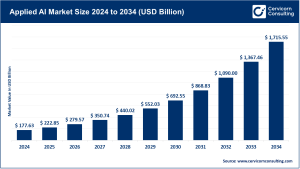Market Overview
The global last mile delivery market was estimated at approximately USD 178.64 billion in 2024 and is expected to reach around USD 484.62 billion by 2034, reflecting a CAGR of 10.49% from 2025 to 2034. Last mile delivery refers to the final stage of moving products from local warehouses or distribution centers directly to customers. Despite being the shortest segment in the logistics chain, it remains the most complex and costly due to traffic congestion, unpredictable delivery points, and high customer expectations. The rapid growth of e-commerce, combined with increasing demand for fast, reliable, and contactless deliveries, has made last mile logistics a key differentiator for businesses.
Get a Free Sample: https://www.cervicornconsulting.com/sample/2625
Key Market Trends
-
Growth of Quick Commerce (Q-Commerce)
Quick commerce emphasizes delivering groceries and essential items within 10–30 minutes, catering to urban consumers’ need for speed and convenience.-
Example: In India, Q-commerce accounted for 40–50% of online grocery purchases in 2024, led by platforms like Blinkit, Zepto, and Swiggy Instamart.
-
Global Projection: The Q-commerce sector is projected to grow at a CAGR of 20% between 2025 and 2034.
-
-
Sustainable Delivery Solutions
Environmental sustainability is becoming crucial, with logistics companies adopting electric vehicles (EVs), bicycles, and optimized delivery routes to reduce carbon emissions.-
Example: DHL deployed 6,100 e-bikes and 13,500 e-trikes, enabling carbon-free deliveries across nearly half of Germany’s districts.
-
Market Projection: The global EV market is expected to surpass USD 2 trillion by 2034, up from USD 348 billion in 2024.
-
-
AI and Route Optimization Technologies
Artificial intelligence is transforming last mile delivery by optimizing routes, predicting delivery windows, and reducing delays.-
Example: Uber Freight’s AI-powered logistics reduced empty truck miles by 10–15%, cutting operational costs.
-
Impact: Smart routing can save up to 25% of delivery time and nearly 20% in fuel consumption.
-
-
Real-Time Tracking and Customer Engagement
Consumers increasingly demand visibility throughout the delivery process, prompting companies to provide real-time tracking and proactive notifications.-
Example: E-commerce giants and courier firms integrate mobile apps and alerts to enhance customer experience.
-
-
Autonomous Delivery Systems
Drones, robots, and autonomous vehicles are gradually entering urban last mile delivery operations.-
Example: Autonomous delivery robots are being used on campuses and in metropolitan areas to reduce delivery time and labor costs.
-
Market Drivers
-
E-Commerce Growth: Online retail continues to fuel demand for last mile delivery, with B2C services capturing 70.51% of revenue in 2024.
-
Rising Consumer Expectations: Same-day or two-hour delivery demands are driving investments in hyperlocal hubs and gig-based delivery models.
-
Technological Advancements: AI, robotics, drones, and autonomous vehicles increase operational efficiency and scalability.
-
Urbanization & Infrastructure Expansion: Rapid urban development intensifies the need for efficient, contactless delivery systems.
-
Environmental Regulations: Global initiatives for carbon reduction encourage the adoption of EVs, e-bikes, and sustainable delivery solutions.
Impact of Trends and Drivers
-
Segmental Influence: E-commerce and retail dominate the market with a 53.92% revenue share in 2024, benefiting from AI-based route optimization and Q-commerce.
-
Regional Impact: North America accounted for 35.84% of market share in 2024, driven by advanced technology adoption and strong e-commerce infrastructure. Emerging regions in Asia, Latin America, and Africa are rapidly growing due to increasing smartphone usage and online commerce.
-
Delivery Models: Standard delivery contributes 56.17% of market revenue, while same-day and instant delivery services are expanding in response to consumer demand for speed.
Challenges & Opportunities
-
Challenges: High operational costs, urban congestion, labor shortages, and regulatory hurdles for autonomous delivery systems.
-
Opportunities: Expansion of Q-commerce, eco-friendly delivery solutions, and AI-powered logistics offer avenues for cost reduction, scalability, and enhanced customer satisfaction.
Future Outlook
Trends such as autonomous delivery, AI-driven route optimization, sustainable logistics, and hyperlocal Q-commerce hubs are expected to reshape the last mile delivery market, making it faster, greener, and more customer-focused.
For a Detailed Overview, Contact Us: Cervicorn Consulting


